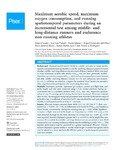Mostrar o rexistro simple do ítem
Maximum aerobic speed, maximum oxygen consumption, and running spatiotemporal parameters during an incremental test among middle- and long-distance runners and endurance non-running athletes
| dc.contributor.author | Casado, Arturo | |
| dc.contributor.author | Tuimil, José Luis | |
| dc.contributor.author | Iglesias, Xabier | |
| dc.contributor.author | Fernández del Olmo, Miguel | |
| dc.contributor.author | Jiménez Reyes, Pedro | |
| dc.contributor.author | Martín Acero, Rafael | |
| dc.contributor.author | Rodríguez, Ferrán A. | |
| dc.date.accessioned | 2023-01-05T11:07:33Z | |
| dc.date.available | 2023-01-05T11:07:33Z | |
| dc.date.issued | 2022-10-05 | |
| dc.identifier.citation | Casado A, Tuimil JL, Iglesias X, Fernández-del-Olmo M, Jiménez-Reyes P, Martín-Acero R, Rodríguez FA. 2022. Maximum aerobic speed, maximum oxygen consumption, and running spatiotemporal parameters during an incremental test among middle- and long-distance runners and endurance non-running athletes. PeerJ 10:e14035 https://doi.org/10.7717/peerj.14035 | es_ES |
| dc.identifier.issn | 2167-8359 | |
| dc.identifier.uri | http://hdl.handle.net/2183/32300 | |
| dc.description.abstract | [Abstract] Background. Maximal aerobic speed (MAS) is a useful parameter to assess aerobic capacity and estimate training intensity in middle- and long-distance runners. However, whether middle- and long-distance runners reach different levels of MAS compared to other endurance athletes with similar VO˙ 2max has not been previously studied. Therefore, we aimed to compare VO˙ 2max, MAS and spatiotemporal parameters between sub-elite middle- and long-distance runners (n = 6) and endurance non-runners (n = 6). In addition, we aimed to compare the maximal blood lactate concentration [BLa] experienced by participants after conducting these tests. Methods. Telemetric portable respiratory gas analysis, contact and flight time, and stride length and rate were measured using a 5-m contact platform during an incremental test at a synthetic athletics track. VO˙ 2, heart rate, respiratory quotient values in any 15 s average period during the test were measured. [BLa] was analyzed after the test . Running spatiotemporal parameters were recorded at the last two steps of each 400 m lap. A coefficient of variation (%CV) was calculated for each spatiotemporal variable in each participant from 8 km h−1 onwards. Results. Whereas runners reported faster MAS (21.0 vs. 18.2 km h−1 ) than nonrunners (p = 0.0001, ES = 3.0), no differences were found for VO˙ 2max and maximum blood lactate concentration during the running tests (p > 0.05). While significant increases in flight time and stride length and frequency (p < 0.001, 0.52 ≤ η 2 p ≤ 0.8) were observed throughout the tests, decreases in contact time (p < 0.001, η 2 p = 0.9) were reported. Runners displayed a greater %CV (p = 0.015) in stride length than nonrunners. We conclude that middle- and long-distance runners can achieve a faster MAS compared to non-running endurance athletes despite exhibiting a similar VO˙ 2max. This superior performance may be associated to a greater mechanical efficiency. Overall, runners displayed a greater ability to modify stride length to achieve fast speeds, which may be related to a more mechanically efficient pattern of spatiotemporal parameters than non-runners. | es_ES |
| dc.language.iso | eng | es_ES |
| dc.publisher | PeerJ Inc. | es_ES |
| dc.relation.uri | https://doi.org/10.7717/peerj.14035 | es_ES |
| dc.rights | Atribución 3.0 España | es_ES |
| dc.rights.uri | http://creativecommons.org/licenses/by/3.0/es/ | * |
| dc.subject | Kinesiology | es_ES |
| dc.subject | Respiratory Medicine | es_ES |
| dc.subject | Biomechanics | es_ES |
| dc.subject | Sports Medicine | es_ES |
| dc.subject | Maximal oxygen uptake | es_ES |
| dc.subject | Performance | es_ES |
| dc.subject | Maximal aerobic speed | es_ES |
| dc.subject | Running | es_ES |
| dc.subject | Spatiotemporal parameters | es_ES |
| dc.title | Maximum aerobic speed, maximum oxygen consumption, and running spatiotemporal parameters during an incremental test among middle- and long-distance runners and endurance non-running athletes | es_ES |
| dc.type | info:eu-repo/semantics/article | es_ES |
| dc.rights.access | info:eu-repo/semantics/openAccess | es_ES |
| UDC.journalTitle | PeerJ | es_ES |
Ficheiros no ítem
Este ítem aparece na(s) seguinte(s) colección(s)
-
GI-PHG - Artigos [118]
-
GI- ACOM - Artigos [40]






